Therapy Helps To Improve Stereoscopic Vision In Stroke Patients
Humans view the world through two eyes, but it is our brain that combines the images from each eye to form a single composite picture. If this function becomes damaged, impaired sight can be the result. Such loss of visual function can be observed in patients who have suffered a stroke or traumatic brain injury or when the oxygen supply to the brain has been reduced (cerebral hypoxia). Those affected by this condition experience blurred vision or can start to see double after only a short period of visual effort. Other symptoms can include increased fatigue or headaches. It is been suggested that these symptoms arise because the brain is unable to maintain its ability to fuse the separate images from each eye into a single composite image over a longer period. Experts refer to this phenomenon as binocular fusion dysfunction.
‘As a result, these patients have significantly reduced visual endurance,’ explains Katharina Schaadt, a graduate psychology student at Saarland University. ‘This often severely limits a patient’s ability to work or go about their daily life.’ Working on a computer screen or reading the newspaper can be very challenging. As binocular fusion is a fundamental requirement for achieving a three-dimensional impression of depth, those affected also frequently suffer from partial or complete stereo blindness. ‘Patients suffering from stereo blindness are no longer able to perceive spatial depth correctly,’ says Schaadt. ‘In extreme cases, the world appears as flat as a two-dimensional picture. Such patients may well have difficulties in reaching for an object, climbing stairs or walking on uneven ground.’
Although about 20% of stroke patients and up to 50% of patients with brain trauma injuries suffer from these types of functional impairments, there is still no effective therapy. Researchers at Saarland University working with Anna Katharina Schaadt and departmental head Professor Georg Kerkhoff have now developed a novel therapeutic approach and have examined its efficacy in two studies. ‘Test subjects underwent a six-week training program in which both eyes were exercised equally,’ explains Schaadt. The aim was to train binocular fusion and thus improve three-dimensional vision. Participants in the study were presented with two images with a slight lateral offset between them. By using what is known as convergent eye movements, patients try to fuse the two images to a single image. This involves directing the eyes inward towards the nose while always keeping the images in the field of view. With time, the two images fuse to form a single image that exhibits stereoscopic depth, i.e. the patient has re-established binocular single vision.
The team of clinical neuropsychologists at Saarland University have used this training programme on eleven stroke patients, nine patients with brain trauma injury and four hypoxia patients. After completing the training programme, a significant improvement in binocular fusion and stereoscopic vision was observed in all participants. In many cases, a normal level of stereovision was attained. ‘The results remained stable in the two post-study examinations that we performed after three and six months respectively,’ says Schaadt. ‘Visual endurance also improved significantly.’ Patients who were able to work at a computer for only 15 to 20 minutes before they began treatment found that they could work at a computer screen for up to three hours after completing the therapeutic training programme.
The results are also of theoretical value to the Saarbrücken scientists, as they provide insight into brain function and indicate that certain regions of the brain that have been become damaged can be reactivated if the appropriate therapy is used.
Journal References:
- Anna-Katharina Schaadt, Lena Schmidt, Caroline Kuhn, Miriam Summ, Michaela Adams, Ruta Garbacenkaite, Eva Leonhardt, Stefan Reinhart, Georg Kerkhoff. Perceptual Relearning of Binocular Fusion After Hypoxic Brain Damage: Four Controlled Single-Case Treatment Studies.. Neuropsychology, 2013; DOI: 10.1037/neu0000019
- A.-K. Schaadt, L. Schmidt, S. Reinhart, M. Adams, R. Garbacenkaite, E. Leonhardt, C. Kuhn, G. Kerkhoff. Perceptual Relearning of Binocular Fusion and Stereoacuity After Brain Injury. Neurorehabilitation and Neural Repair, 2013; DOI: 10.1177/1545968313516870
Comment: I am so sorry to tell you, this isn’t NEW for us as a Neuro-Developmental and Behavioral Optometry, we did this for decade already.


